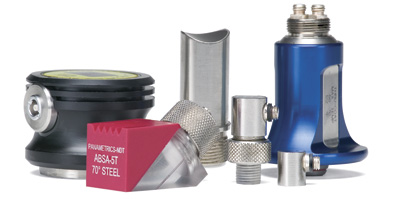用于厚度测量的探头类型

All transducers that are commonly used with ultrasonic thickness gauges incorporate a vibrating ceramic element in a case, but their designs fall into four general categories.
Contact transducers: As the name implies, contact transducers are used in direct contact with the test piece. A thin, hard wearplate protects the active element from damage in normal use. Measurements with contact transducers are often the simplest to implement, and they are usually the first choice for most common thickness gauging applications other than corrosion gauging.
Delay line transducers: Delay line transducers incorporate a cylinder of plastic, epoxy, or fused silica known as a delay line between the active element and the test piece. A major reason for using them is for thin material measurements, where it is important to separate the excitation pulse recovery from back wall echoes. A delay line can be used as a thermal insulator, protecting the heat-sensitive transducer element from direct contact with hot test pieces, and delay lines can also be shaped or contoured to improve sound coupling into sharply curved or confined spaces.
Immersion transducers: Immersion transducers use a column or bath of water to couple sound energy into the test piece. They can be used for in-line or in-process measurement of moving product, for scanned measurements, or for optimizing sound coupling into sharp radiuses, grooves, or channels.
Dual element transducers: Dual element transducers, or simply "duals," are used primarily for measurements involving rough, corroded surfaces. They incorporate separate transmitting and receiving elements mounted on a delay line at a small angle to focus sound energy a selected distance beneath the surface of a test piece. Although measurement with duals is sometimes not as accurate as with other types of transducers, they usually provide significantly better performance in corrosion survey applications.